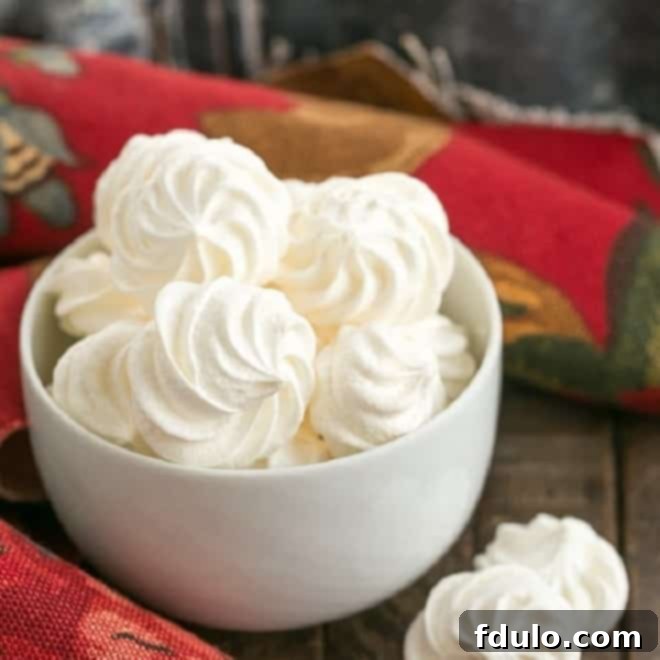Meringue cookies are a true culinary delight – impossibly light, wonderfully crisp, and delicately sweet. Made with just four simple ingredients, these ethereal egg white cookies promise to melt in your mouth and satisfy your deepest sweet cravings. Whether you’re a seasoned baker or trying your hand at meringues for the first time, this comprehensive guide to our easy meringue cookie recipe will ensure your batch turns out perfectly every time. Get ready to transform leftover egg whites into stunning, delectable treats!
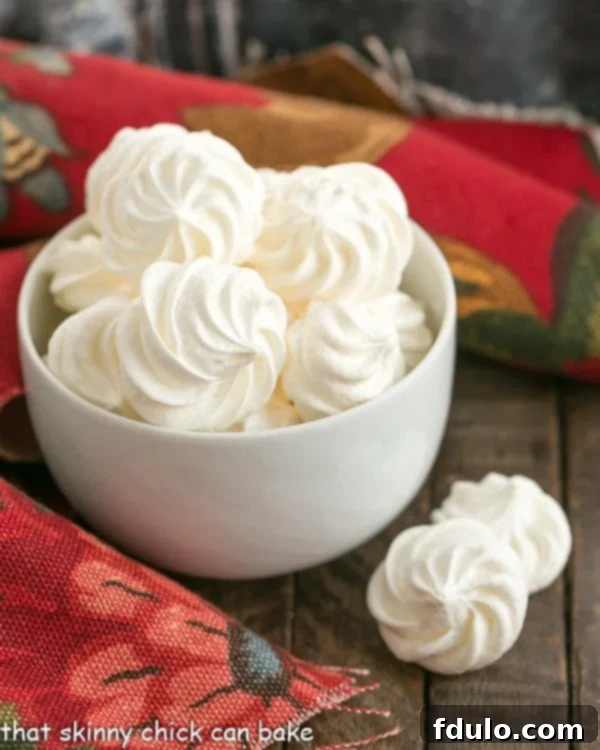
Why These Simple Meringue Cookies Deserve a Spot in Your Kitchen
There are countless reasons to fall in love with making your own homemade meringue cookies. They’re not just a delicious dessert; they’re a versatile canvas for creativity and a brilliant solution for common kitchen dilemmas.
- Effortless Elegance: With only four core ingredients and a straightforward process, these beautiful cookies deliver impressive results without extensive effort. They look elegant on any dessert platter, making them perfect for special occasions or simply elevating an everyday treat.
- Utilize Leftover Egg Whites: If you often find yourself with spare egg whites after making custards, hollandaise, or ice cream, this recipe is your ideal solution. Instead of discarding them, transform them into these delightful, melt-in-your-mouth cookies.
- Customization at Your Fingertips: While our basic recipe yields pure, pristine white meringues, these cookies are incredibly adaptable. Easily incorporate food coloring to match any holiday or theme – think vibrant greens for St. Patrick’s Day, soft pinks for Valentine’s, or cheerful pastels for Easter. Experiment with flavorings like almond extract, peppermint, or citrus zest for endless variations.
- A Versatile Dessert Component: Beyond enjoying them on their own, these crisp meringues are a fantastic base for more elaborate desserts. Crush them to create a delightful texture in parfaits, trifles, or a classic Eton Mess, like our Strawberry Eton Mess with Homemade Strawberry Sauce.
- Naturally Gluten-Free: For those with dietary restrictions, meringue cookies are a wonderful naturally gluten-free option, ensuring everyone can enjoy a sweet treat.
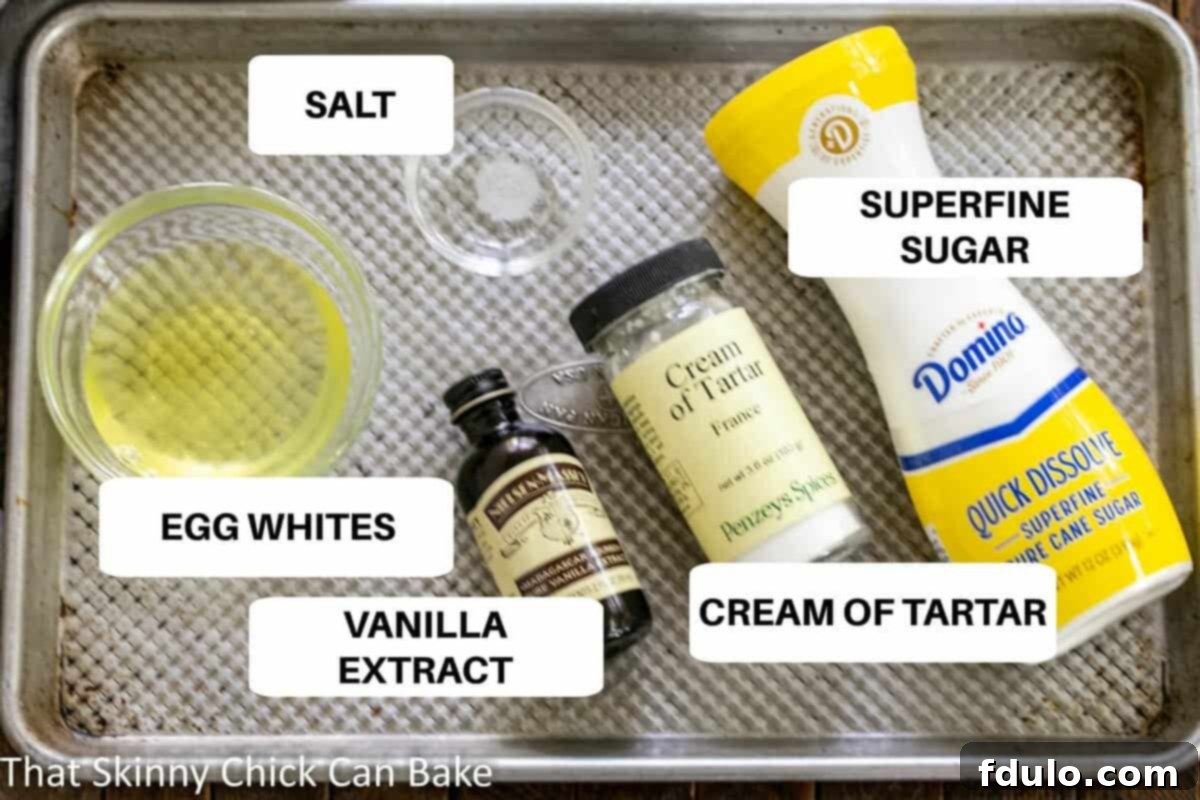
Essential Ingredients for Perfect Meringue Cookies
Crafting perfect meringue cookies begins with understanding the role of each ingredient. Despite their simplicity, the quality and preparation of these four components are key to success.
- Egg Whites: These are the star of the show, providing the structure and airy texture. For optimal volume and stability, always use egg whites that are at **room temperature**. Cold egg whites won’t whip up as easily or achieve the same lofty peaks. If your eggs are straight from the fridge, you can quickly bring them to room temperature by placing them (still in their shells) in a bowl of warm water for 5-10 minutes. It’s also vital that your egg whites are free from any speck of yolk, as fat will prevent them from whipping properly.
- Cream of Tartar: This acidic powder acts as a stabilizer for the egg whites, helping them hold their structure and preventing them from deflating. It promotes faster whipping and results in a stronger, more stable meringue. If you don’t have cream of tartar on hand, you can substitute it with an acid like white vinegar or lemon juice. Use twice the amount (e.g., ½ teaspoon of white vinegar for ¼ teaspoon of cream of tartar). The acid helps denature the egg white proteins, allowing them to form a stronger network when whipped.
- Pinch of Salt: While often overlooked in sweet recipes, a small pinch of salt is crucial. It brightens and enhances the sweetness of the sugar and balances the overall flavor profile of your meringue cookies. Think of it as a flavor amplifier, making the simple sweetness even more captivating.
- Superfine Sugar: Also known as caster sugar, superfine sugar is highly recommended for meringues because its finer granules dissolve more easily and quickly into the egg whites. This reduces the risk of grainy meringues and helps achieve a smooth, glossy, stable mixture. While superfine sugar is preferred, regular granulated sugar can certainly be used – you’ll just need to beat the mixture a little longer to ensure it fully dissolves. Many markets carry superfine sugar in the baking aisle. You can also make your own by pulsing regular granulated sugar in a food processor for about 30 seconds, though some purists argue store-bought superfine sugar has a superior consistency for meringues.
Unleash Your Creativity: A Versatile Meringue Base
While these simple meringue cookies are perfect in their pure white form, especially when destined for a classic Strawberry Eton Mess where vanilla might affect the color, their versatility is boundless. Consider them a blank canvas for your baking artistry!
Imagine the possibilities: a drop of green food coloring and a hint of mint extract for festive St. Patrick’s Day treats; vibrant pink with a touch of rosewater or raspberry extract for a romantic Valentine’s Day gesture; or a palette of pastel colors and lemon or orange zest for a delightful Easter gathering. These egg white cookies can be customized for any season, celebration, or craving. You can even swirl in cocoa powder for chocolate meringues or add a touch of instant espresso for a coffee-flavored twist. The key is to add any liquid extracts or food coloring towards the end of the whipping process, just before stiff peaks form, to avoid affecting the meringue’s structure.
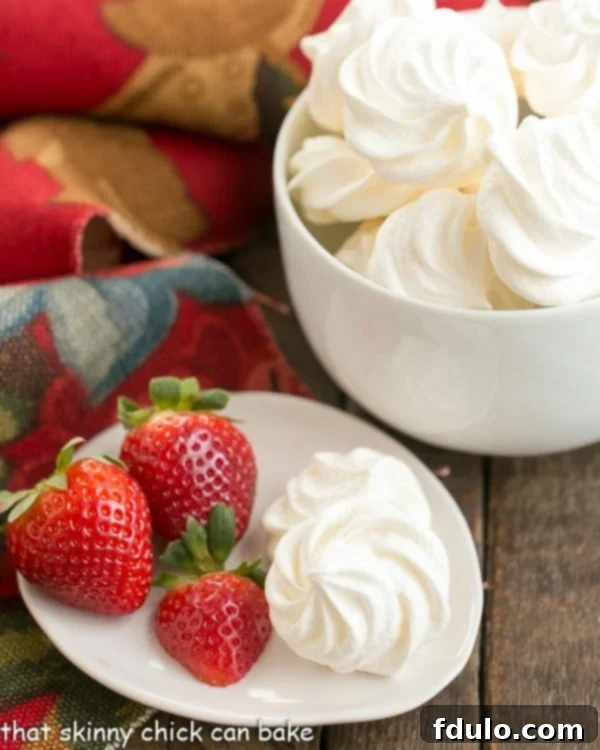
Mastering Meringues: Tried and True Expert Advice
With years of experience making everything from lemon meringue pie to delicate pavlovas, I’ve gathered invaluable insights into creating flawless meringues. These expert tips are your secret weapon for consistently perfect, crisp, and airy meringue cookies.
- Room Temperature Egg Whites are Non-Negotiable: As mentioned, egg whites at room temperature whip up faster and achieve greater volume than cold ones. This is because the proteins are more relaxed and able to incorporate air more efficiently, resulting in a lighter, more stable foam.
- Cleanliness is Paramount: This is arguably the most crucial tip. Any trace of grease, oil, or egg yolk in your mixing bowl or on your beaters will prevent the egg whites from whipping properly. Even a tiny speck of fat can completely deflate your meringue. Always use scrupulously clean, dry glass or metal bowls (plastic bowls can retain grease). Wipe down your bowl and beaters with a paper towel dampened with lemon juice or white vinegar before starting to ensure they are perfectly clean.
- Separate Eggs Carefully: To avoid yolk contamination, crack each egg on a flat surface (not the edge of the bowl) and separate the yolk from the white while the eggs are still cold, directly from the refrigerator. Cold yolks are firmer and less likely to break. Separate each egg white into a small, separate bowl before adding it to your main mixing bowl. This way, if one yolk breaks, it only contaminates that single egg white, not the entire batch.
- Whip to Soft Peaks Before Adding Sugar: Begin by whipping the egg whites until they are frothy and then continue until soft peaks form. This means that when you lift the beaters, the meringue holds its shape but the tip gently curls over. Adding sugar too early can hinder the initial aeration process.
- Gradual Sugar Addition is Key: Once soft peaks are achieved, add the superfine sugar slowly, about one tablespoon at a time, with the mixer running. Allow about 30-60 seconds between each addition for the sugar to fully dissolve. This gradual process ensures the sugar incorporates smoothly, creating a stable, glossy meringue rather than a grainy, weeping one. Rushing this step is a common mistake that leads to less-than-perfect results.
- Test for Dissolved Sugar: My mother taught me this trick: periodically stop the mixer and rub a small amount of the meringue between your thumb and forefinger. If you can still feel sugar granules, continue beating until the mixture is smooth and glossy. Fully dissolved sugar is essential for a stable, non-weeping meringue.
- Achieve Stiff, Glossy Peaks: Continue whipping after all the sugar is added until stiff, glossy peaks form. When you lift the beaters, the meringue should stand straight up without drooping, and the mixture should look shiny and smooth. Be careful not to over-beat, which can cause the meringue to become dry and crumbly.
- Consider Vanilla or Other Flavorings: While I often omit vanilla to keep meringues a pure, pristine white (as vanilla extract has a slight color), feel free to add ½ teaspoon of pure vanilla extract or other flavorings like almond, peppermint, or citrus zest. Add these at the very end of the whipping process.
- Bake Low and Slow, Then Dry: Meringues are dried, not baked, in a low oven. This slow process removes moisture without browning the cookies. After the initial baking time, turn off the oven and leave the meringues inside for an extended period (an hour or more, or even overnight) to dry out completely. This prevents cracking and ensures a perfectly crisp interior. Do not open the oven door during this drying phase.
- Humidity is the Enemy: Meringues absorb moisture from the air, so baking on a dry, low-humidity day is ideal. If you bake on a humid day, your meringues might turn out sticky or chewy instead of crisp. Store them immediately in an airtight container once completely cooled.
Step-by-Step Guide to Making Perfect Meringue Cookies
Follow these simple steps to create beautiful, crisp meringue cookies that will impress everyone.

- Prepare Your Oven and Baking Sheets: Preheat your oven to a low temperature, typically 225°F (105°C). Line one or two baking sheets with parchment paper. This prevents sticking and makes cleanup a breeze.
- Whip Egg Whites to Frothy Stage: In a very clean, dry mixing bowl, place your room temperature egg whites. Using an electric mixer (handheld or stand mixer), begin beating them on medium speed until they become frothy and foamy, with small bubbles covering the surface.
- Add Stabilizer and Beat to Soft Peaks: Add the cream of tartar and a pinch of salt to the frothy egg whites. Increase the mixer speed to medium-high and continue beating until soft peaks form. At this stage, when you lift the beaters, the meringue should hold its shape but the very tip will gently curl over.
- Gradually Add Sugar for Stiff Peaks: With the mixer still running on medium-high speed, slowly begin adding the superfine sugar, one tablespoon at a time. Allow each addition to incorporate for about 30 seconds before adding the next. Continue beating until all the sugar is dissolved and stiff, glossy peaks form. The meringue should be thick, smooth, and shiny, and hold its shape firmly when the beaters are lifted. If using, gently fold in vanilla extract or other flavorings at this point.
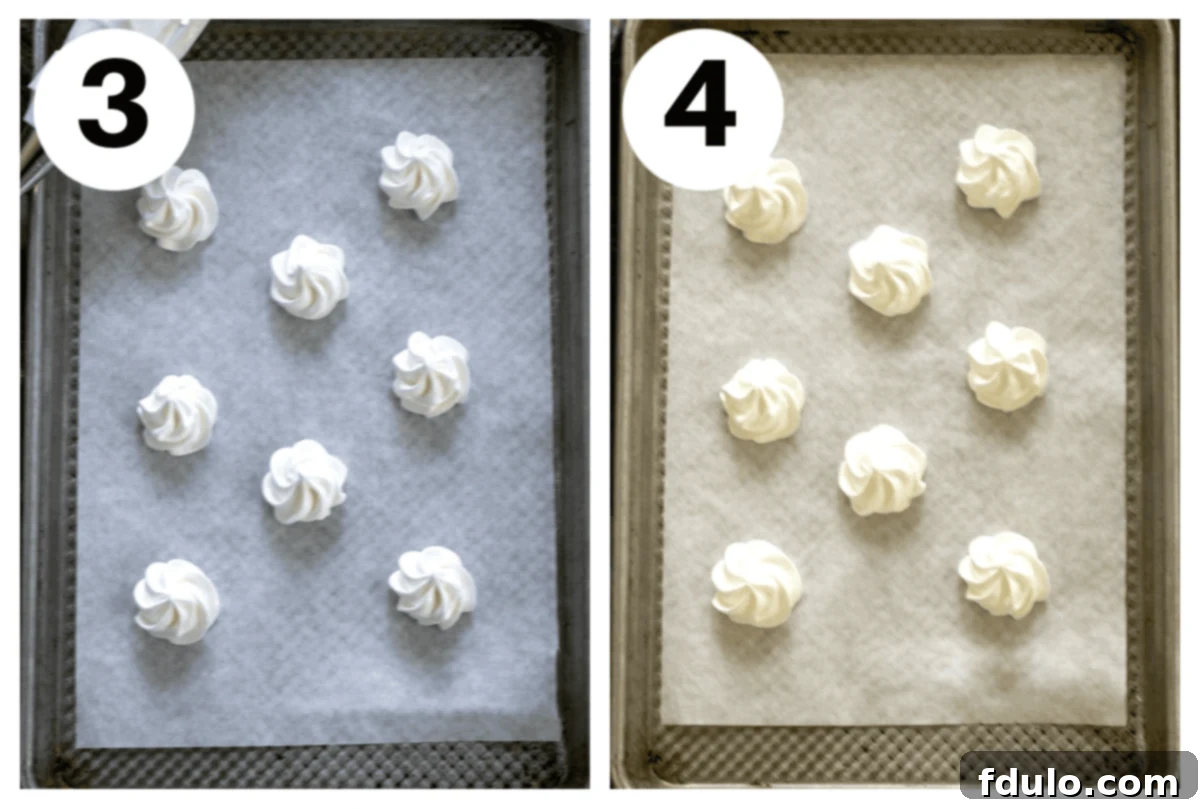
- Pipe or Drop Meringue onto Baking Sheets: Transfer the meringue mixture to a piping bag fitted with your desired tip (a large star tip like a 1M creates beautiful swirls) or simply use two spoons to drop dollops onto the parchment-lined baking sheets. Space the meringues about 2 inches apart to allow for airflow.
- Bake and Dry: Place the baking sheets in the preheated oven and bake for 45 minutes. After 45 minutes, turn off the oven but do not open the oven door. Let the meringues remain in the cooling oven for at least 1 hour, or even longer (up to several hours or overnight for maximum crispness). This crucial drying step ensures the meringues become perfectly crisp and dry throughout. Once completely cooled, they are ready to enjoy!

These versatile and simple meringue cookies are fantastic on their own, or as the star ingredient in a layered Strawberry Eton Mess, combining crushed meringues, fresh berries, and luscious whipped cream.
Creative Ways to Use Leftover Egg Yolks
Making meringue cookies is a fantastic way to use up egg whites, but what about the yolks? Don’t let those golden treasures go to waste! Beyond adding them to a hearty batch of scrambled eggs for a richer breakfast, there’s a world of delicious possibilities:
- Indulgent Custards and Crème Brûlée: Egg yolks are the foundation of many creamy, luxurious desserts. Whip up a batch of my Classic Crème Brûlée (which uses 7 egg yolks) or a White Chocolate Crème Brûlée (4 yolks) for an elegant treat. These rich, velvety desserts perfectly complement the light crispness of meringues.
- Rich Pots de Crème: For a decadent, individual dessert, try my Irish Cream Pots de Creme, which uses 6 egg yolks. These smooth, intensely flavored custards are a delightful contrast to airy meringues.
- Homemade Ice Cream or Custard Bases: Many premium ice cream recipes rely on an egg yolk custard base for unparalleled richness and creaminess.
- Hollandaise Sauce or Mayonnaise: For savory applications, egg yolks are essential for emulsified sauces like classic Hollandaise (perfect for Eggs Benedict!) or homemade mayonnaise, offering superior flavor and texture compared to store-bought versions.
- Lemon Curd: A vibrant, tangy lemon curd makes excellent use of several egg yolks and is a fantastic topping for toast, scones, or other desserts.
By making these simple meringue cookies and then a rich, yolk-based dessert, you’ll be well on your way to a culinary feast with no waste!
Frequently Asked Questions About Meringue Cookies
The absolute key to storing meringue cookies is protecting them from humidity. Once completely cooled, they should be stored in an airtight container at room temperature. Avoid refrigerating, as the humid environment can make them soft and sticky.
When properly stored in a cool, dry, airtight container at room temperature, meringue cookies can stay fresh and crisp for up to 2 weeks. If you wish to store them longer, they can be frozen for several months. Just ensure they are in a freezer-safe, airtight container to prevent freezer burn and moisture absorption. Thaw at room temperature.
Meringue can indeed be finicky, but most failures stem from a few common issues:
- Fat Contamination: This is the most frequent culprit. Even a tiny speck of egg yolk, grease from your bowl or beaters, or residual oil can prevent egg whites from whipping up properly. Ensure all equipment is impeccably clean and dry.
- Under-Beating: Not whipping the egg whites enough before adding sugar can result in a weak, unstable meringue that won’t hold its shape. They need to reach soft peaks first.
- Over-Beating: Whipping egg whites too long, especially after sugar is added, can make the meringue dry, crumbly, and prone to cracking or weeping. Stop once stiff, glossy peaks are formed.
- Sugar Not Dissolved: If sugar granules remain, your meringues can become grainy, sticky, or weep. Add sugar slowly and beat until smooth.
- Humidity: High humidity in the air (or oven) can make meringues sticky and soft instead of crisp. Try to bake on a dry day.
- Opening Oven Door Too Soon: Opening the oven door during baking or the cooling-drying process can cause the meringues to crack or deflate due to sudden temperature changes.
While superfine (caster) sugar is ideal, some recipes do use powdered (confectioners’) sugar. However, powdered sugar often contains cornstarch, which can affect the texture of the meringue. It might make them chewier or softer rather than perfectly crisp. For best results, stick to superfine or granulated sugar.
The ideal meringue consistency for piping cookies is thick, glossy, and holds stiff peaks. When you lift the beaters, the meringue should stand straight up without curling or collapsing. It should feel smooth, not grainy, when rubbed between your fingers.
Explore More Delicious Egg-White Desserts and Cookie Recipes
If you’ve fallen in love with these simple meringue cookies, you’ll be delighted to discover other fantastic recipes that utilize egg whites, as well as a selection of my most cherished dessert and cookie creations.
- Strawberry Meringues Recipe from Pint-Sized Baker: A fruity twist on the classic.
- Lemon Souffle (Uses 9 egg whites): Light, airy, and bursting with citrus flavor.
- Layered Chocolate Meringue Cake (Uses 6 egg whites): A show-stopping dessert with contrasting textures.
- Chocolate Velvet Pie with Meringue Crust (Uses 3 egg whites): Rich chocolate filling topped with delicate meringue.
- Strawberry Souffle Recipe (Uses 4 egg whites): A light and fruity individual dessert.
- Fresh Strawberry Meringue Cake (Uses 7 egg whites): Layers of sweet meringue and fresh berries.
- Chocolate Meringues (Uses 6-7 egg whites): For the chocolate lovers!
- Classic Lemon Meringue Pie: A timeless favorite with a towering meringue topping.
- Discover more of my Best Dessert Recipes.
- Explore a wide array of my favorite Cookie Recipes.
With only four simple ingredients, these elegant meringue cookies are not only incredibly easy to prepare but also deliver a truly delightful experience for your palate. While I often skip vanilla to maintain their pristine white color, feel free to add a touch of pure vanilla extract if you prefer. The beauty of this recipe lies in its adaptability, so don’t hesitate to experiment with other flavorings to create your unique signature treats!
Stay connected and share your baking triumphs with me on social media! Find me on Instagram, Facebook, and Pinterest. Don’t forget to tag me when you whip up one of my recipes! If you love the results, please consider leaving a 5-star rating in the recipe card below.
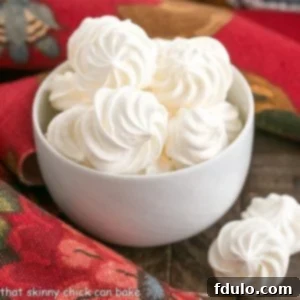
Simple Meringue Cookies
15 minutes
45 minutes
1 hour 45 minutes
Approximately 24 cookies
Sweet, ethereal, and incredibly easy, this meringue recipe uses just 4 simple ingredients to create light, crisp egg white cookies that melt in your mouth.
Ingredients
- 2 large egg whites, at room temperature
- ¼ teaspoon cream of tartar
- A pinch of salt (approximately ⅛ teaspoon)
- ½ cup superfine sugar (caster sugar), or regular granulated sugar
- ½ teaspoon vanilla extract, optional (for pure white meringues, omit)
Instructions
- Preheat oven to 225º Fahrenheit (105°C). Line a baking sheet (or two, depending on size) with parchment paper.
- Place egg whites into a very clean, dry mixing bowl. Beat on medium speed until frothy, then add the cream of tartar and the pinch of salt. Continue beating until soft peaks form.
- With the mixer running on medium-high, slowly add sugar, one tablespoon at a time, allowing each addition to dissolve for 30-60 seconds. Continue beating until all sugar is incorporated and stiff, glossy peaks form. If using, gently fold in the vanilla extract.
- Transfer the meringue mixture to a piping bag fitted with a large star tip (like 1M) or use two spoons to drop tablespoons of meringue onto the prepared baking sheet, spacing them approximately 2 inches apart.
- Bake for 45 minutes. After 45 minutes, turn the oven off completely.
- Without opening the oven door, let the meringues stand in the cooling oven for 1 hour (or longer, up to several hours or overnight for crisper results). This allows them to dry out thoroughly and prevents cracking.
Notes
Egg whites will not whip properly if any grease or egg yolk contaminates the bowl or beaters. Ensure all equipment is scrupulously clean and dry.
The vanilla extract is optional. Including it will result in cookies that are slightly off-white, but the flavor is wonderful. Adjust to your preference.
Once your meringues have completely cooled to room temperature, store them in an airtight container to maintain crispness.
The yield can vary depending on the size of the meringue cookies you pipe or drop.
Important Note: Meringues bake best on a dry day. Avoid making them on high-humidity days, as excess moisture in the air can cause the meringues to become soft, chewy, or sticky.
Recommended Products
As an Amazon Associate and member of other affiliate programs, I earn from qualifying purchases.
- 1M Piping Tip
- Superfine Sugar
- KitchenAid 9-Speed Digital Hand Mixer
Nutrition Information:
Yield:
12
Serving Size:
2 cookies
Amount Per Serving:
Calories: 35Total Fat: 0gSaturated Fat: 0gTrans Fat: 0gUnsaturated Fat: 0gCholesterol: 0mgSodium: 20mgCarbohydrates: 8gFiber: 0gSugar: 8gProtein: 1g
HOW MUCH DID YOU LOVE THIS RECIPE?
Please leave a comment on the blog or share a photo on Pinterest
